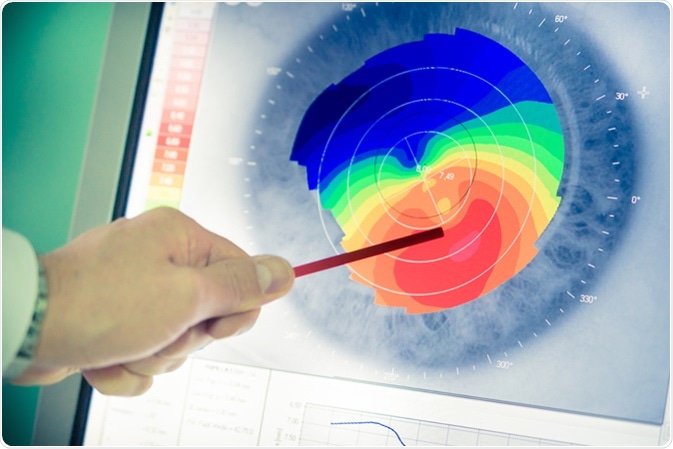
What is Wavefront Aberrometry?
Diagnosing the degree of vision impairment is a difficult task for even experienced optometrists, since it depends on the subjective response of the person tested. Normally, it is based on reading out or describing letters or shapes on an eye chart. In many cases the person may not actually be reading out the letter seen, but the letter thought to be seen.
A solution has been developed for this issue, which is known as wavefront aberrometry.

Image Credit: Emiliano Pane / Shutterstock
Light is thought of as being a traveling wave, with the shape of the wave reflecting the movement of individual light photons. As this passes through the normal eye, the front of the wave (‘wavefront’) presents a flat shape, while irregularities in the wavefront represent defects in vision.
The specific types and degrees of aberrations in the shape of the wavefront reflect the different kinds of problems present in the eye. Consequently, aberrometry represents a technique of measuring these changes or distortions in the path the light travels.
What are the advantages of wavefront aberrometry?
Wavefront aberrometry is an objective method of measuring refractive power, using a tool to measure the manner in which a light beam moves through the tested eye.
It offers detailed measurements of the movement of the light wavefront.
In this way it can be used in the diagnosis of both higher-order and lower-order refractive errors. Higher-order errors refer to conditions that include complex visual defects, unlike lower-order errors such as nearsightedness, farsightedness and astigmatism.
In addition, the technique is useful as a guide in making of spectacles and contact lenses to offer sharper and clearer vision.
Formerly, higher-order aberrations such as spherical aberration were ignored, both in surgical and lens correction. However, being able to detect and evaluate them has allowed better vision correction and even fewer post-surgical artefacts.
How is wavefront aberrometry performed?
Commonly, the person places the chin on a chin rest built into the aberrometer and looks into the instrument at a spot of light. The light passes through the pupil and is reflected back by the retina. The wavefront of the reflected beam is recorded and compared to that of the reference wavefront. All the points of variation are recorded and measured, creating in turn an optical fingerprint.
The method used to identify vision errors is based on wavefront measurements, calculated using Zernike polynomials. This produces a topographic image of the distorted wavefront. This is used to design very accurate correction lenses or to guide refractive surgery. In fact, it is actually used intraoperatively to deliver maximum accuracy of lens correction following phakic surgery.
There are three different ways to analyze the aberrometry findings. These are outgoing wavefront aberrometers, ingoing retinal imaging aberrometers, and ingoing feedback aberrometers. The technique employed will change the speed at which results are available, the range of refractive error, as well as the potential to analyze and measure different aberrations.
Nevertheless, it is better to combine these methods with medical imaging or with topographic maps. With proper analysis, wavefront aberrometry enables the detection and treatment of conditions that impair vision at each stage of light passage through the eye. This includes all the stages from the tear film in front of the cornea to the retina itself. It also aids to understand how contact lenses actually affect the whole optic system of the eye.
Sources
Further Reading
Last Updated: Apr 3, 2019






















.png)










No hay comentarios:
Publicar un comentario